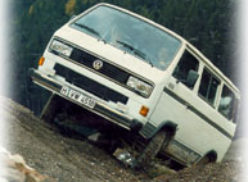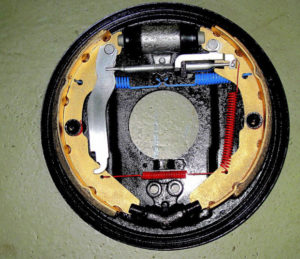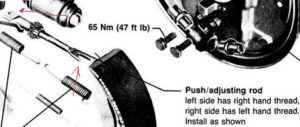By Ken Wilford
Why Vanagon Rear Brakes are Evil and How to make them Good…
Rear brakes on a Vanagon have probably driven me more crazy than any other part of the van. You can put all new brake parts on a van and if you don’t adjust the rear brakes properly your brakes will feel like crap. You can easily improperly install the rear adjusters so that they won’t work, and many of the springs in the rear only go a certain specific way or else they will jam up the adjuster as well. I have learned all of these lessons the hard way. Finally the rear drums can cause major pulsing pedal that you would think is coming from the front brakes because it is so pronounced.
My tips for best performance of rear brakes: Get as much new parts as you can before doing the job. You don’t want to get into the job and not have rear wheel cylinders, etc. that you are going to need.
Rear Drums
I’m not sure if it is really worth turning rear drums. If the drums look smooth on the inside and are within limits then I would clean them with brake cleaner and reuse them but if you have a pulse pedal suspect a bad drum. Replace drums only in pairs. If you have them turned be sure they are only turned in pairs and match each other’s diameter.
Look at the picture above and at the pictures in the Bentley Manual if you have had poor brake performance and compare it to what is installed on your van. Many times I have found parts improperly installed by a brake shop that didn’t know/didn’t care what they were doing. Pay particular attention to the springs that are directly below the adjuster and rear wheel cylinder. They are made so that the hooks grab the center tabs from underneath. This allows the adjuster to clear. You can easily install them upside down but this jams up the adjuster.
As for the adjuster itself it has two ends, both of which need to be installed properly. One end looks like a split boat paddle with one longer piece and one shorter piece. This end goes toward the emergency brake lever. The longer piece needs to get on the inside of the brake shoe metal plate (toward the backing plate) and the shorter side is out where you can see it. The other end looks like a squared off paddle that is much shorter and squatter. One side is square and the other side has a small notch cut out of it. The squared side should be out where you can see it and the other side with the notch out of it should be behind the brake shoe metal plate (toward the backing plate).
Final adjustment:
Once you have everything properly installed, the final adjustment is the key to getting a high pedal and also a good e-brake. Adjust the brake adjuster until you can’t slide the drum on any longer. Now back off the adjuster in five click increments until you can just put the drum on. You don’t want to have to force it on that is too tight. But when it is on you want to hear a dragging noise when you turn it and also a little bit of resistance. Now go inside and try the e-brake cable. It should only pull up three or four clicks. If it goes higher then you still need to adjust the shoes out a bit farther. Put drums on and then try the pedal. It should feel hard and high. If not adjust some more.
That is it. I properly adjusted set of rear brakes will give you great e-brake, smooth braking and also a high pedal that feels great!


